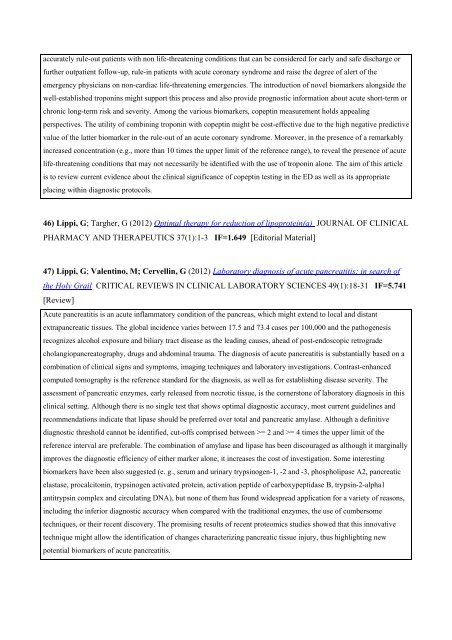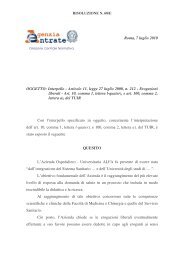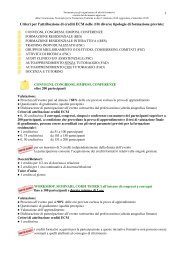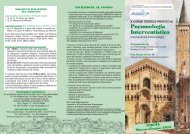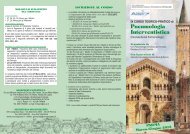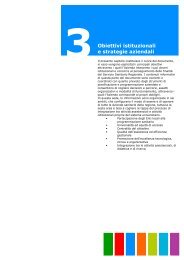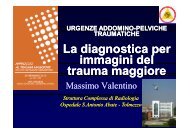COLLEGIO DI DIREZIONE - Azienda Ospedaliera di Parma
COLLEGIO DI DIREZIONE - Azienda Ospedaliera di Parma
COLLEGIO DI DIREZIONE - Azienda Ospedaliera di Parma
Create successful ePaper yourself
Turn your PDF publications into a flip-book with our unique Google optimized e-Paper software.
accurately rule-out patients with non life-threatening con<strong>di</strong>tions that can be considered for early and safe <strong>di</strong>scharge or<br />
further outpatient follow-up, rule-in patients with acute coronary syndrome and raise the degree of alert of the<br />
emergency physicians on non-car<strong>di</strong>ac life-threatening emergencies. The introduction of novel biomarkers alongside the<br />
well-established troponins might support this process and also provide prognostic information about acute short-term or<br />
chronic long-term risk and severity. Among the various biomarkers, copeptin measurement holds appealing<br />
perspectives. The utility of combining troponin with copeptin might be cost-effective due to the high negative pre<strong>di</strong>ctive<br />
value of the latter biomarker in the rule-out of an acute coronary syndrome. Moreover, in the presence of a remarkably<br />
increased concentration (e.g., more than 10 times the upper limit of the reference range), to reveal the presence of acute<br />
life-threatening con<strong>di</strong>tions that may not necessarily be identified with the use of troponin alone. The aim of this article<br />
is to review current evidence about the clinical significance of copeptin testing in the ED as well as its appropriate<br />
placing within <strong>di</strong>agnostic protocols.<br />
46) Lippi, G; Targher, G (2012) Optimal therapy for reduction of lipoprotein(a) JOURNAL OF CLINICAL<br />
PHARMACY AND THERAPEUTICS 37(1):1-3 IF=1.649 [E<strong>di</strong>torial Material]<br />
47) Lippi, G; Valentino, M; Cervellin, G (2012) Laboratory <strong>di</strong>agnosis of acute pancreatitis: in search of<br />
the Holy Grail CRITICAL REVIEWS IN CLINICAL LABORATORY SCIENCES 49(1):18-31 IF=5.741<br />
[Review]<br />
Acute pancreatitis is an acute inflammatory con<strong>di</strong>tion of the pancreas, which might extend to local and <strong>di</strong>stant<br />
extrapancreatic tissues. The global incidence varies between 17.5 and 73.4 cases per 100,000 and the pathogenesis<br />
recognizes alcohol exposure and biliary tract <strong>di</strong>sease as the lea<strong>di</strong>ng causes, ahead of post-endoscopic retrograde<br />
cholangiopancreatography, drugs and abdominal trauma. The <strong>di</strong>agnosis of acute pancreatitis is substantially based on a<br />
combination of clinical signs and symptoms, imaging techniques and laboratory investigations. Contrast-enhanced<br />
computed tomography is the reference standard for the <strong>di</strong>agnosis, as well as for establishing <strong>di</strong>sease severity. The<br />
assessment of pancreatic enzymes, early released from necrotic tissue, is the cornerstone of laboratory <strong>di</strong>agnosis in this<br />
clinical setting. Although there is no single test that shows optimal <strong>di</strong>agnostic accuracy, most current guidelines and<br />
recommendations in<strong>di</strong>cate that lipase should be preferred over total and pancreatic amylase. Although a definitive<br />
<strong>di</strong>agnostic threshold cannot be identified, cut-offs comprised between >= 2 and >= 4 times the upper limit of the<br />
reference interval are preferable. The combination of amylase and lipase has been <strong>di</strong>scouraged as although it marginally<br />
improves the <strong>di</strong>agnostic efficiency of either marker alone, it increases the cost of investigation. Some interesting<br />
biomarkers have been also suggested (e. g., serum and urinary trypsinogen-1, -2 and -3, phospholipase A2, pancreatic<br />
elastase, procalcitonin, trypsinogen activated protein, activation peptide of carboxypeptidase B, trypsin-2-alpha1<br />
antitrypsin complex and circulating DNA), but none of them has found widespread application for a variety of reasons,<br />
inclu<strong>di</strong>ng the inferior <strong>di</strong>agnostic accuracy when compared with the tra<strong>di</strong>tional enzymes, the use of cumbersome<br />
techniques, or their recent <strong>di</strong>scovery. The promising results of recent proteomics stu<strong>di</strong>es showed that this innovative<br />
technique might allow the identification of changes characterizing pancreatic tissue injury, thus highlighting new<br />
potential biomarkers of acute pancreatitis.


